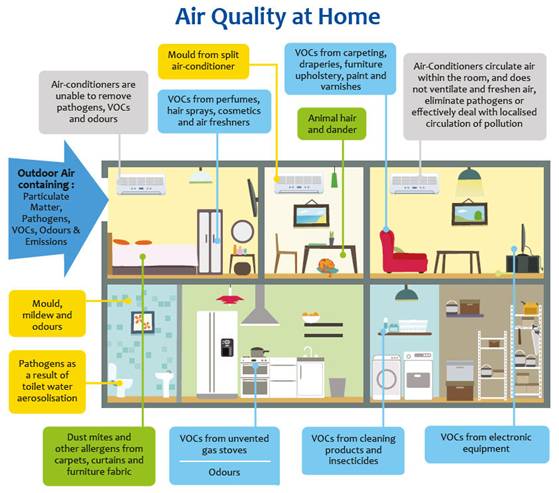Indoor Air Pollution Fundamentals Explained
Table of ContentsThe Buzz on Air QualityEverything about Air Quality10 Simple Techniques For Indoor Air PollutionThe Best Strategy To Use For Air Quality
Formaldehyde levels were less of an issue. Fortunately there are ways to address these problems. One is to make sure your stove has a ventilator hood, and also to make sure you're using it regularly. Some people in colder climates may avoid using theirs since they send warm air up and out of the home.Using wood or charcoal to heat your home may be a quaint way to stay warm, but it also adds harmful substances to the air you breathe. Worldwide nearly half of all people use simple stoves or open fires to keep warm. And that has led to some extremely unfortunate consequences.

Radon is a radioactive gas that bubbles up from the ground as naturally occurring uranium breaks down (air quality). And if your home has cracks, a basement, or a crawlspace, this odorless gas can find its way in, raising the risk of lung cancer in your home. And that's true of one out of every 15 U.S.
Also, it doesn't matter if your home is new or old—homes of any age can potentially be affected. Since this radioactive gas can't be seen, smelled, or tasted, it takes a special test to know if your home has a radon leak. Fortunately this is a test anyone can do for as little as $10.
All About Indoor Air Pollution
The next time you whip out an air-freshening candle, plugin, or spray, consider what else you may be releasing into your air besides the fresh scent. air quality. Air fresheners have been found to contain phthalates, formaldehyde, and other harmful chemicals, and often those chemicals are not listed among the product's ingredients as they may be considered trade secrets.
What are phthalates? Phthalates are used commercially to soften plastics, make nail polish more adherent, and can be found in perfumes as well. But these chemicals are also known to interfere with hormone production, reduce sperm production, and cause birth defects. While this may be cause for concern, some experts say the research hasn't proven these products are dangerous.
But if you have children, remember that smaller amounts of toxins can be more dangerous to their little bodies, so extra caution may be best. Pretty much everyone has some amount of formaldehyde in their homes. The organic compound known for its use as an embalming fluid is also used in various household products, and when it is released into the air, formaldehyde can irritate your skin, eyes, nose, go to my site and throat, and may cause breathing problems.
These products release most of their formaldehyde after two years. But what if you've recently furnished your home? There are still ways to reduce the formaldehyde from the air you breathe. Try opening up the windows for a few minutes every day. Keep your home temperatures cool. Don't allow people to smoke in your home.

How Indoor Air Pollution can Save You Time, Stress, and Money.

To reduce your risks, carefully follow the instructions on your pesticides package. Be careful choosing exterminators. If you need to mix pesticides, do so outdoors. And whenever possible, avoid pesticides and find more natural ways to reduce the pests in your home. The home isn't the only place where you'll find indoor air quality problems.

They emit tiny particles small enough to enter useful site the human bloodstream by burrowing deep within our lungs. That can hurt your lungs and heart. One study found that printer emissions are worse when toner cartridges are fuller, and when lots of toner is being used in a printing job. They claim to help clean your air.
The problem comes from air cleaners that emit ozone. Ozone exists in abundance high in the earth's atmosphere, but it is only found in small quantities closer to the earth's surface. One exception is smog, which contains a large concentration of ozone. The EPA has developed a phrase for ozone: “good up high, bad nearby.†When you breathe ozone, it can damage your lungs.
Indoor Air Pollution Fundamentals Explained
And the longer you breathe it, and the higher the concentration, the more harm it can cause. These devices have been peddled for more than a century, and for almost as long, scientific studies have found them both ineffective and dangerous. They don't remove carbon monoxide as many manufacturers claim, and they don't remove dust or pollen.